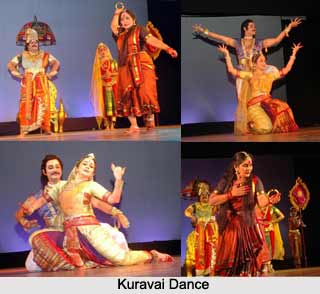 Kuravai Dance is related to war-operations during "Silappathikaram" days. This dance is basically the spontaneous expressions of joy over victory. The courageous deeds of the king are praised through music and its composition. In Kuravai dance, the rhythm needs to be brisk; with fast limb movements and tunes that match the tempo. The sound of war-drums also creates the necessary ambience.
Kuravai Dance is related to war-operations during "Silappathikaram" days. This dance is basically the spontaneous expressions of joy over victory. The courageous deeds of the king are praised through music and its composition. In Kuravai dance, the rhythm needs to be brisk; with fast limb movements and tunes that match the tempo. The sound of war-drums also creates the necessary ambience.
History of Kuravai Dance
Kuravai Dance performed in Muruga temples are found to be mentioned in the Tamil epic "Silappathikaram". A victorious king is joined by soldiers and they together dance on the deck of the king"s chariot. A victorious king is followed by war-heroes and "Viraliyar", who dance as a group hailing the names of the victorious king.
Performance of Kuravai Dance
Kuravai Dance, portrayed in the epic depicts the image of seven girls standing in a circle and dancing to the melody "Mullaippann". The seven girls represent the seven musical notes of the Tamil scale which are "Kural", "Tuttam", "Kaikkilai", "Ulai", "Ili", "Vilari" and "Taram". The circle known as "Vattappalai" accommodates the girls at specific points on the circumference. Musical notes are represented in four ways- linear, square, triangular and circular.
A circle is drawn with its diameter and the four cardinal points East, West, South and North are marked at the terminals. At each of the four angles, two more lines are drawn thus making provision for marking the twelve signs of the "Zodiac". Information is provided by the commentaries as to where the seven notes are located in the Zodiac - the twelve signs representing the twelve semi-tones in the octave.
This article is a stub. You can enrich by adding more information to it. Send your Write Up to content@indianetzone.com




